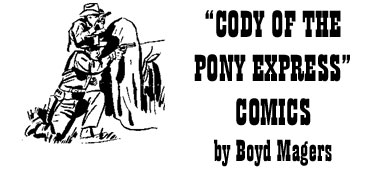Chapter Thirty-Seven
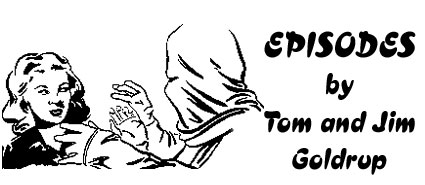
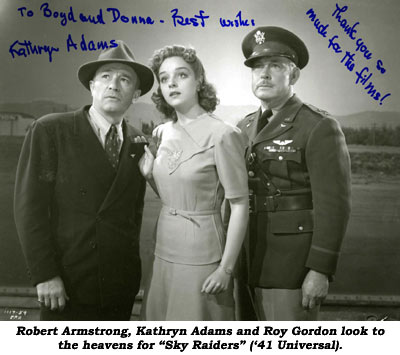
Kathryn Adams co-starred with Donald Woods and Billy Halop, Robert Armstrong, Eduardo Cianelli and Reed Hadley in Universal’s 1941 serial, “Sky Raiders”. The advertisements for this serial read, “The most sensational sky-serial ever made,” and “Amazing air adventures as heroes battle spies in the sky.” The plot for the story (screenplay by Clarence Upson Young and Paul Huston, based on an original story by Eliot Gibbons) involved foreign agents trying to steal a new pursuit plane developed by a World War I flying ace. Henry MacRae (who produced the “Flash Gordon” serials) produced with two directors for the 12 chapter serial, Ford Beebe and Ray Taylor.
Kathryn Adams was born July 15, 1920, in Minnesota, making her film debut in 1939 opposite Ginger Rogers and Tim Holt in “Fifth-Avenue Girl”. Regarding her work in “Sky Raiders”, Kathryn told us, “The serial was, as the kids say today, ‘a hoot’ all the way through. It really is an historic document, isn’t it? The techniques of filming have changed so much over the years that ‘Sky Raiders’seems like a contribution to the Antique Road show, which is the way I felt about myself when I attended my first film festival in Memphis. One of the reasons the serial was so much fun for me was because one of the producers, Don Brown, became a good friend and he would fill me in daily about how they would search for stock shots that fit the action, and then create the dialogue to match the stock shots.”
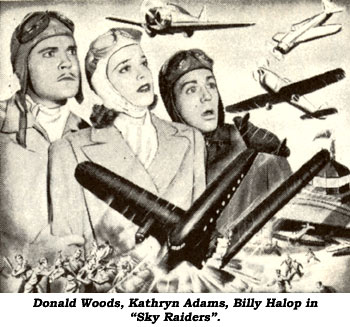 “An example of this was the bear episode (Ch. 10). Actually, there wasn’t a hair of a bear on the set, only when they cut the film, a stock shot was inserted of one lazy looking bear nibbling on a forest delight. End of episode: I am terrified and run like the wind to escape the unaware bear. In another episode the plane I was piloting in the San Bernadino Mountains crashes. End of episode. Beginning of next episode, I’m tripping through the forest with unmussed hair and, I believe, high heels, calling and calling, ‘Tim! Tim!’ who also managed between episodes to escape the crash without a scratch. Chapter Eleven: Don Woods and I are co-piloting a plane over the Pacific Ocean on our way to Hawaii when the plane explodes in the air over the Pacific Ocean—stock shot of plane bursting into flames, disappearing into the ocean depths and leaving nothing but a faint oil slick. End of episode. Opening of final episode: Don Woods and I are sitting in the captain’s quarters of a coast guard cutter, hair a bit damp and mussed, but looking quite unscathed. The Captain calmly asks, ‘Captain Drayton, will you be going on to Hawaii?’ ‘Yes, sir, as soon as the plane is repaired,’ Captain Drayton answers. We do fly to Hawaii, return, are married, the villain caught, and all is well that ends well! End of serial!” “An example of this was the bear episode (Ch. 10). Actually, there wasn’t a hair of a bear on the set, only when they cut the film, a stock shot was inserted of one lazy looking bear nibbling on a forest delight. End of episode: I am terrified and run like the wind to escape the unaware bear. In another episode the plane I was piloting in the San Bernadino Mountains crashes. End of episode. Beginning of next episode, I’m tripping through the forest with unmussed hair and, I believe, high heels, calling and calling, ‘Tim! Tim!’ who also managed between episodes to escape the crash without a scratch. Chapter Eleven: Don Woods and I are co-piloting a plane over the Pacific Ocean on our way to Hawaii when the plane explodes in the air over the Pacific Ocean—stock shot of plane bursting into flames, disappearing into the ocean depths and leaving nothing but a faint oil slick. End of episode. Opening of final episode: Don Woods and I are sitting in the captain’s quarters of a coast guard cutter, hair a bit damp and mussed, but looking quite unscathed. The Captain calmly asks, ‘Captain Drayton, will you be going on to Hawaii?’ ‘Yes, sir, as soon as the plane is repaired,’ Captain Drayton answers. We do fly to Hawaii, return, are married, the villain caught, and all is well that ends well! End of serial!”
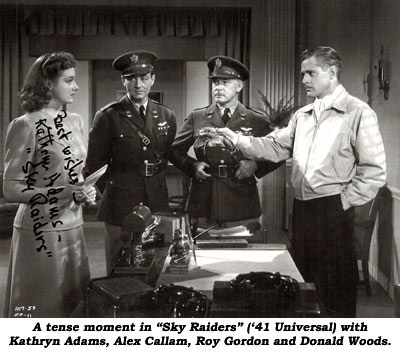
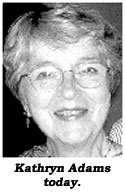 “As far as my co-actors are concerned, all were warm, friendly, considerate. Donald Woods and I did several B-pictures together besides the serial and enjoyed working together. It was a good fit. The director, Ray Taylor, happened to be from Perham, MN, so we enjoyed one another. Not a single glitch that I can remember. It was a good experience and it has grown even better in looking back…one of the rewarding things about aging.” “As far as my co-actors are concerned, all were warm, friendly, considerate. Donald Woods and I did several B-pictures together besides the serial and enjoyed working together. It was a good fit. The director, Ray Taylor, happened to be from Perham, MN, so we enjoyed one another. Not a single glitch that I can remember. It was a good experience and it has grown even better in looking back…one of the rewarding things about aging.”
Kathryn has one other serial to her credit, that being an unbilled bit in Ch. 1 of “Junior G-Men of the Air” in 1942.

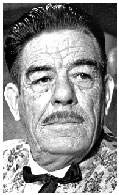 Glenn Strange regarding “Hurricane Express” (‘32): “We made most of it up on Mulholland Drive and over on Sepulveda Blvd. There wasn’t anything out there then but orange orchards and lemons and what not. We’d shoot late at night, dubbing the sound later. They had lights that looked kinda like a fryin’ pan. Dark as pitch but these are for daylight shots. I’d stand here and hold the light in John Wayne’s face…the camera over here—‘yakety, yakety, yak’—then I’d get in his spot. They wouldn’t change the camera. He’d get over here and I’d get where he was. He’d hold the light in my face (and I’d do dialogue). Now the wreck of the plane—remember (the plot) was a plane trying to run a railroad out of business. We had one of these old Tri-motor Fords. We used a bunch of this old corrugated iron, piled it up on the railroad track off Sepulveda Blvd., put a lot of smoke screens under it and that was the crash. (Laughs) We were down at the old Glendale Airport and they’d taxi—they never did get off the ground. We’d lean out the windows with the machine guns—acka–acka–acka—then they’d cut to the plane in the air somewhere.” Glenn Strange regarding “Hurricane Express” (‘32): “We made most of it up on Mulholland Drive and over on Sepulveda Blvd. There wasn’t anything out there then but orange orchards and lemons and what not. We’d shoot late at night, dubbing the sound later. They had lights that looked kinda like a fryin’ pan. Dark as pitch but these are for daylight shots. I’d stand here and hold the light in John Wayne’s face…the camera over here—‘yakety, yakety, yak’—then I’d get in his spot. They wouldn’t change the camera. He’d get over here and I’d get where he was. He’d hold the light in my face (and I’d do dialogue). Now the wreck of the plane—remember (the plot) was a plane trying to run a railroad out of business. We had one of these old Tri-motor Fords. We used a bunch of this old corrugated iron, piled it up on the railroad track off Sepulveda Blvd., put a lot of smoke screens under it and that was the crash. (Laughs) We were down at the old Glendale Airport and they’d taxi—they never did get off the ground. We’d lean out the windows with the machine guns—acka–acka–acka—then they’d cut to the plane in the air somewhere.”
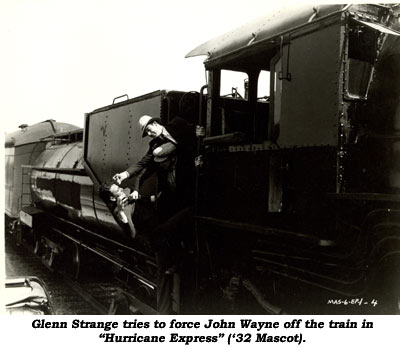
“On the serial ‘Riders of Death Valley’ (‘41) was the first time anybody ever broke me up in a scene. I just wouldn’t let ‘em break me up. I just divorced my mind from what they were saying. But Leo Carrillo broke me up! He and I and Big (Boy Williams) were ridin’ up this little canyon and we’re stoppin’ like we was listening and Leo said, ‘Shhhh’—his dialogue was, ‘I think I hear hoofbeats.’ And he said (very effeminate with a distinct Spanish accent), ‘Shhhh—I think I hear the footprints approaching.’ (Laughs) I like to fell offa my horse! He would do these things purposely. He didn’t really talk like that!”
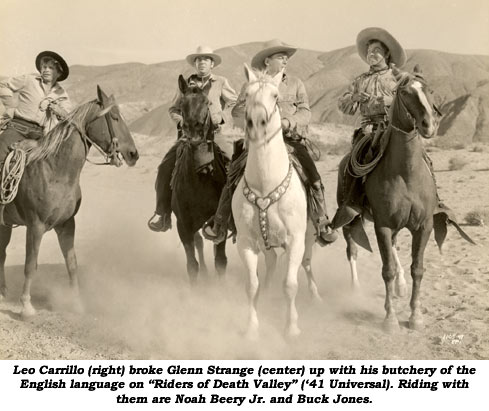
Re “Flash Gordon” (‘36): “Big Ol’ Tiny playing one of the ones that had the wings…great big ol’ guy, he jumped on my foot and broke my little toe. (Probably John Lipson as Vultan—ed.) Just crushed my little toe! You know the guy that worked with me who he was? We wore what looked like five gallon oil cans down over our heads. (Ming’s metal clad palace guards.—ed.) Red Christy—Howard Christy that later produced ‘Wagon Train’. He’d just come down from college and he was a good friend of Edmund Grainger who was running the studio (Universal) then. Grainger’s son and Red were buddies up in college and he went to work—just gettin’ into the business. Pretty soon he was an assistant director and graduated right on up to producer.” Strange also played a robot and the lobster-clawed Gocko monster in “FG”.
Glenn Strange (1899-1973)
Serial Credits:
“Hurricane Express” (Mascot ‘32)
“Shadow of the Eagle” (Mascot ‘32)
“Law of the Wild” (Mascot ‘34)
“Flash Gordon” (Universal ‘36)
“Phantom Rider” (Universal ‘36)
“Lone Ranger Rides Again” (Republic ‘39)
“Flying G-Men” (Columbia ‘39)
“Riders of Death Valley” (Universal ‘41)
“Overland Mail” (Universal ‘42)

Ch. 4 of “Cody of the Pony Express” shows the stage hit a bump with Cody falling into the seat-boot as the stage hurtles over the cliff. But Ch. 5 omits his fall and has Cody thrown clear as the stage hits that bump. |
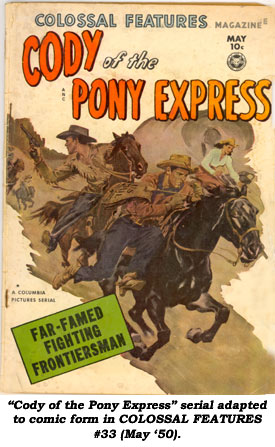 Columbia adapted many popular comic strip and comic book heroes to the serial screen— “Mandrake, The Magician”, “Terry and the Pirates”, “Capt. Midnight”, “Batman”, “The Phantom”, “Brenda Starr, Reporter”, “The Vigilante”, “Brick Bradford”, “Tex Granger”, “Superman”, “Congo Bill”, “Bruce Gentry”, “King of the Congo” (Thunda), “Blackhawk”, etc., but “Cody of the Pony Express” in 1950 seems to be the only one of two cliffhangers ever to have a comic book generated from a serial. The other was Fawcett’s adaptation of Republic’s “Jungle Girl”. Columbia adapted many popular comic strip and comic book heroes to the serial screen— “Mandrake, The Magician”, “Terry and the Pirates”, “Capt. Midnight”, “Batman”, “The Phantom”, “Brenda Starr, Reporter”, “The Vigilante”, “Brick Bradford”, “Tex Granger”, “Superman”, “Congo Bill”, “Bruce Gentry”, “King of the Congo” (Thunda), “Blackhawk”, etc., but “Cody of the Pony Express” in 1950 seems to be the only one of two cliffhangers ever to have a comic book generated from a serial. The other was Fawcett’s adaptation of Republic’s “Jungle Girl”.
“Cody of the Pony Express”, produced by Sam Katzman, directed by the renown Spencer Gordon Bennet, starred Dickie Moore as Cody and Jock O’Mahoney as Lt. Jim Archer.
The Fox Feature Syndicate began a two issue adaptation of the 15 chapter serial in COLOSSAL FEATURES #33 (May ‘50),
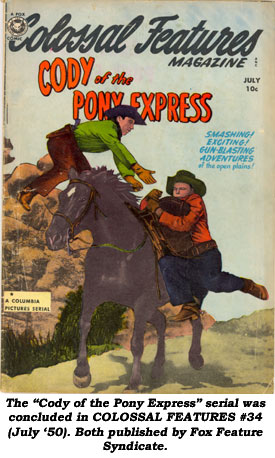 concluding the serial in #34 (July ‘50). Interior art by Pete Morisi, for the most part was pretty dreadful with renderings of O’Mahoney, Moore, Peggy Stewart (blonde in one issue, brunette in the next!) pretty much unrecognizable. concluding the serial in #34 (July ‘50). Interior art by Pete Morisi, for the most part was pretty dreadful with renderings of O’Mahoney, Moore, Peggy Stewart (blonde in one issue, brunette in the next!) pretty much unrecognizable.
Following the serial adaptation, Fox issued CODY OF THE PONY EXPRESS #1 (Sept. ‘50) which retained only the Cody, Ezra Graham (William Fawcett) and Linda (Peggy Stewart) characters. The three stories had nothing to do with the Columbia serial.
The series was abandoned until Charlton idiotically reprinted only the first half of the two-part Fox adaptation in their revived CODY OF THE PONY EXPRESS #8 (10/55)—also severely edited due to Comics Code changes. Charlton’s CODY… #9 reprinted one story from Fox’s CODY…#1. CODY…#10 contained Buffalo Bill Cody stories (yellow goa-tee and all) with no connection at all to the serial.
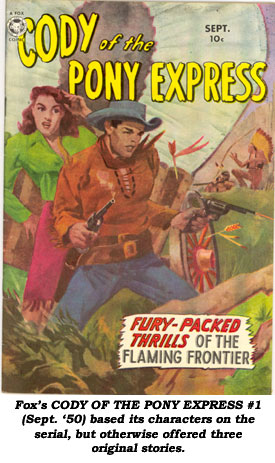
Incidentally, a no-number issue of WOMEN OUTLAWS issued by Fox (probably sometime in ‘51, the issue is not dated) reprints their own CODY… #1 with an unrelated female-outlaw cover. Go figger!
It’s too bad other serials weren’t converted to comic book form, although Universal’s “Scouts To the Rescue”, “Oregon Trail” and “The Phantom Creeps” were in MOVIE COMICS 1-6 in ‘39. We’ll cover them and “Jungle Girl” next time.

In Ch. 8 of “Cody of the Pony Express”, outlaw Ben Corbett “arrives” with others, although they’d been in the serial for 7 chapters already! Then Ben is knocked off his horse in the desert by Cody, but somehow he must be twins, as he’s also miles away attacking a relay station with other outlaws. Holy Continuity! |
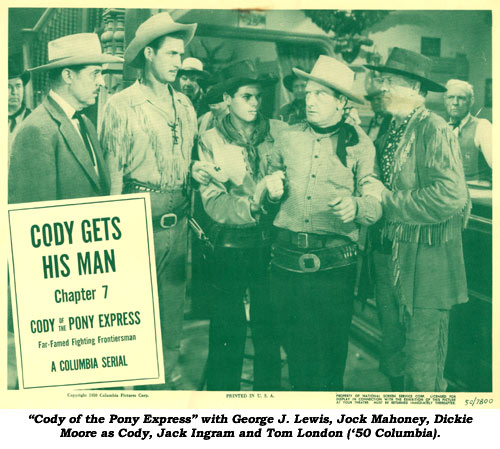
top of page |


